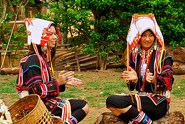Myanmar is a fascinating country for the rest of the world not just because it came out of seclusion in 2011, but also because it is the most eth- nically diverse country in South East Asia. It is in fact, multi-ethnic, multi-religious and multi-lingual. The country’s strategic loca- tion in Asia and highly fertile land also rich in natural resources, made it a favored desti- nation for migrants from neighboring coun- tries, who stayed on, to form this ethnically diverse population today.
Of late, the term ‘ethnic’ has been cropping up frequently with Myanmar’s ethnic groups coming in the limelight. What does ‘ethnic’ really mean? Ethnic is a term that points to an association with or the state of belong- ing to a specific group of people, who have a distinct culture, language, and religion. Eth- nicity is a distinct feature of every nation’s demographics.
The concept of ethnicity in Myanmar is com- plex and politically sensitive primarily due to the ethnic plurality found in the country. In 1989, the decision of the government to change the country’s name from Burma to Myanmar, was the biggest recognition of the various ethnic groups residing in its States
and Divisions, since the name Myanmar en- compasses all the ethnic minorities. Myan- mar has been accepted by the people, and most countries, though some countries con- tinue to call it Burma.
Myanmar’s Ethnic Groups
Historically, Myanmar existed as a unified kingdom, back in the 8-9th century A.D, when the Burmans are believed to have mi- grated southwards from the Eastern Hima- layas, which led to a 500-year dynastic rule. Subsequently, for centuries, different ethnic groups formed kingdoms and exercised complete control over the entire country, till the advent of British in 1824. The British Rule encouraged Indians and Chinese peo- ple to migrate and participate in Myanmar’s economic activities, and making the popula- tion even more diverse.
Today, 8 main ethnic groups are officially recognized, which have been further divid- ed by the government into 135 indigenous ethnic groups. These groups have highly distinctive identities in terms of culture, language, dress and living styles. Though Burmese is the most widely spoken lan- guage, these ethnic groups have been able to retain over a hundred different dialects that are spoken even today. It is these distinctive features that each ethnic group considers to be an integral part of their national identity. Myanmar’s first census in thirty years was conducted between 29th March to 10th April of 2014 and the preliminary results were revealed soon after. The data of ethnic population is still yet to be published. But the data from the census conducted thirty years ago shows the respective percentage of the various officially recognized ethnic groups as:
Burmans 68 % Shan 9% Karen 7% Rakhine 4% Chinese 3% Indian 2% Mon 2% Others 5%
The Burmans are spread in predominantly urban areas, the bigger towns and cities, and the alluvial plains of the country. The ethnic minorities have settled in the hilly ar- eas along the country’s borders with neigh- boring Thailand, Laos, Bangladesh, China and India. With urbanization and develop- ment, this is likely to change and intermix- ing of ethnic groups has already increased in larger cities like Yangon and Mandalay where people come in search of work.
Burmans/Bamars
The Burmans or Bamars are the largest ethnic group in Myanmar and they occupy the central plains around the Irrawady and Sittang rivers. Agriculture is their main oc- cupation. They speak the Burmese language and almost all Burmans are Buddhists, practicing Theravada Buddhism.
Shan
Shan is the second biggest ethnic group forming 9% of the population, approximate- ly half of which lives in the Shan state on the northeastern hilly part of Myanmar. The other half of the Shan reside in communi- ties spread over Mandalay Division, Kachin and Karen States. Shan state is very rich in natural resources like minerals, gems and teak wood. The Shan have a striking simi- larity to the Thais since they are ethnically related, and even speak a similar language. The Shan are religiously divided into two groups, with one practicing Theravada Bud- dhism and the other being Christians.
Karen
There are an estimated 7 million Karen (or Kayin) people forming one of the larger ethnic groups in Myanmar. They are be- lieved to have migrated from Mongolia in to Myanmar around 3000 BC, much before the Burman and Mon ethnic groups, but there is no historical evidence to prove this. They live mainly in the South and South Eastern part of the country, and only one-fourth live within the Karen State. In terms of religion, they practice both Buddhism and Christi- anity, though a small section practices An- imism.
Mon
The Mon people are widely believed to be the first inhabitants of Myanmar and are also among the first settlers in South East Asia though originally from Southwestern China. The Mon are largely responsible for the spread of Theravada Buddhism and the Shwedagone Pagoda has also been built by the Mon. The Burmese script has also been derived from the Mon script. The Mon people reside mainly in the Mon State in Southern Myanmar bordering the Bago and Tanintharyi Regions and the Karen State.
Chin
The Chin people live in the north western Chin state that borders India. Of Tibe- to-Burman origin, they are estimated to be 1.5 million in number. The Chin people fol- low Christianity, Theravada Buddhism and some still have tribal beliefs. A section of the Chin population lives as refugees in India. Arakenese/Rakhine
The Rakhine State was previously called Arakan, and its residents therefore have been known as Arakanese. They are ethni- cally linked to the Burmans, speak a dialect similar to Burmese, but are culturally dis- tinct. Majority of the Arakanese are Bud- dhists, though some are Christians and a very few are Muslims as well.
Immigrants in Myanmar
Myanmar’s history shows immigration to be an outcome of colonialism after 1824. Prior to 1824, no settlements of foreigners were found in the erstwhile Burma, where over a hundred ethnic groups lived with unity within the country’s borders.
Population estimates reveal 3% to be Chi- nese and 2% Indians residing in Myanmar. The migrants gained access to the country after an administrative link came up be- tween India and Myanmar during British Rule. The census data collected in 1931 by the British Administration revealed 7% of the population to be Indian. Yangon was ac- tually a city of immigrants since they formed two-thirds of its population, and of this, 53% were Indians. The Indian community in Myanmar flourished during British Rule since they dominated the fields of education and trade, besides the Civil Service. Indians from the states of West Bengal, Tamil Nadu, Gujarat and Maharashtra came to trade or work in the agricultural sector, and even- tually dominated the textile industry, hard- ware and gold trading segments. A large part of the capital used for agricultural ex- pansion in the delta region came from Indi- an moneylenders. Indians also formed part of the educated elite and served as doctors, lawyers and teachers.
Myanmar’s 1000-km long border with In- dia with three checkpoints provided am- ple opportunity for Indians to illegally en- ter Myanmar. Till World War II, Indians formed the largest minority community, but fled in large numbers during the Jap- anese invasion. Though many did return after the war, they were unable to get back their dominant position in the country’s commercial activities. The second exodus of Indians took place between 1950-65, when they moved back to India or to neighbor- ing Thailand. This can be attributed to the economic nationalization by the socialist government ruling at that time, which took away their wholesale and retail businesses, and the land reform policy post indepen- dence took back all the land belonging to people of Indian origin. The repatriation of 100,000 Indians was part of a program to increase the wealth and economic holdings of the local Myanmar nationals.
The British also recruited Chinese immi- grants from Singapore and Malaya. They worked in the mines in Shan State, built rice mills, ran small businesses and were part of the urban work force. At present the Chinese form roughly 2% of the total population and are engaged in commercially profitable activities.
Chinese immigration can also be attributed to the countries being neighbors with a 2171- km border between the two nations. Access by road and sea brought the first Chinese from Yunan, and traders from the coastal areas of Guangdong, followed later via the sea route. The British encouraged more Chinese traders to settle in Yangon, previously called Rangoon. The fate of the Chinese was similar to that of the Indians in the 1960s, since the Bur- mese government’s nationalization of assets caused considerable economic damage to them, and forced to leave for greener pas- tures. Only a small section of the Chinese continues in Myanmar, running lucrative businesses. Mandalay, the second largest city after Yangon, has 30-40% Chinese in its population.
There have been immigrants illegally infil- trating into the country through the not- so-secure borders, a large section of which are believed to be from neighboring Bangla- desh.
Today, Myanmar is an amalgamation of its various ethnic groups, people of Indian and Chinese origin, and a steadily growing ex- patriate community that is participating in its growth and development, and through them Myanmar is forging alliances and building relationships with other countries.










